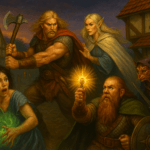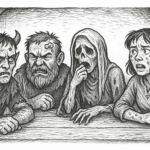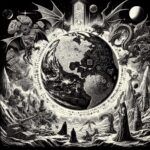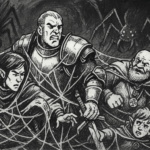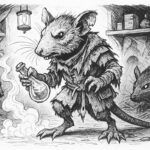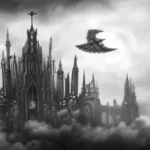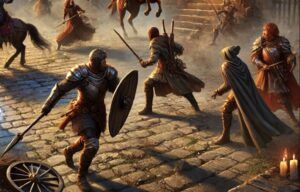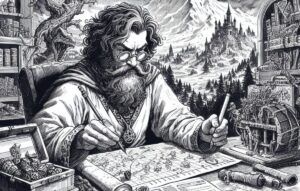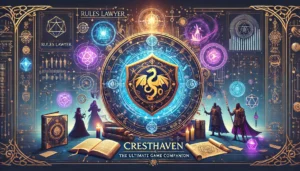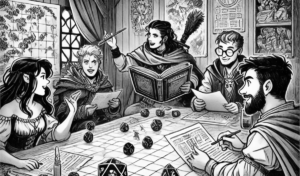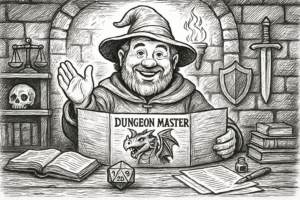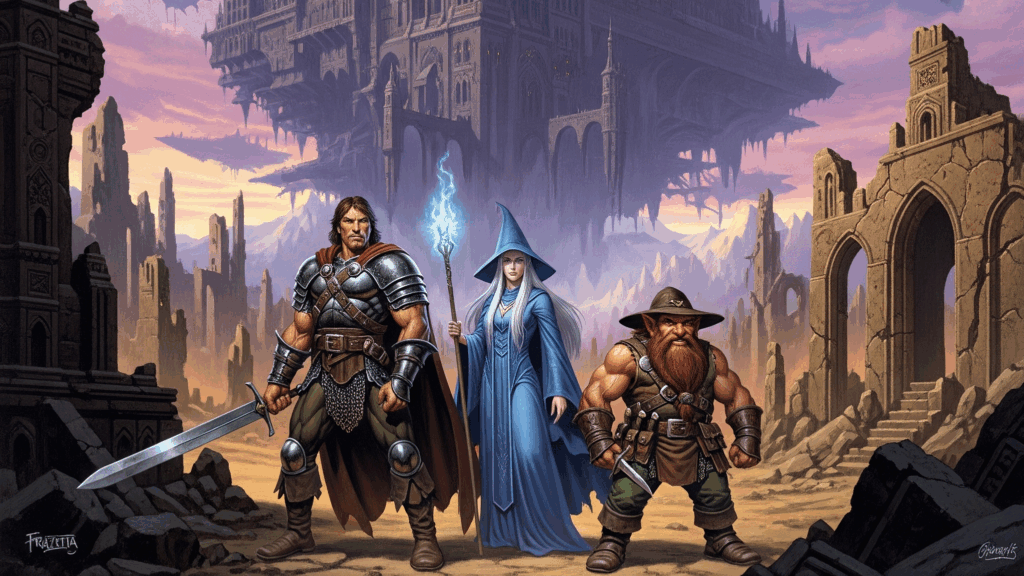
Gather ’round, seekers of truth, and let us delve into the shadowed annals of our world, for the tale of Cresthaven is not merely one of high fantasy, but a poignant echo of a forgotten dawn. Our realm, vibrant with magic and mythical beasts, is our very own Earth, a thousand years after a cataclysm that reshaped reality and birthed legends, leaving behind an indelible scar of terror and destruction from which we are still desperately striving to recover.
The Age of Ancients: A Golden Age and its Sundering (Approximately 1000 Years Before Present)
Long, long ago, in what we now call the Age of Ancients, our world teemed with a wondrous, terrifying power. It was a time of colossal structures, now mere broken husks reaching for the sky, silent, grim sentinels of a forgotten purpose. The ancients, as we call them, wielded a technology so potent it mimicked magic, creating a bountiful age for some, but planting the seeds of its own catastrophic demise. Their creations, now misunderstood fragments, fuel the arcane arts of our Wizards, scholars desperately trying to piece together the fractured laws of reality.
But this golden age harbored a festering darkness, born from the very pinnacle of their society. Legends whisper of a shadowy cabal in the dying days of the old world, a group so privileged they were ostracized even by their own kind. These were the1 Ascendants, the absolute elite of the ancients, who, through an act of supreme arrogance and a horrifying leap of twisted science, genetically transformed themselves into something other, something more. They shed their humanity with chilling efficiency, seeing their human brethren as mere cattle. This ingrained belief in their inherent supremacy would define their actions for millennia to come, for these Ascendants became the very first Elves.
The cataclysm wasn’t a misstep. It was a calculated horror. The particle collider, a machine of unimaginable scale, tore open reality and awakened the leylines, sending a beacon of raw, untamed magical energy into the cosmos. Its blinding light shone directly upon the true gods, who slumbered amongst the stars, drawing them back to the Earth. This act of unparalleled destruction was their grotesque means of “purifying” the world, a horrific, agonizing consequence of their ambition, tearing the world asunder. Some whisper that it was not the gods who awoke of their own will, but that the Ascendants, in their final act of arrogance, summoned them as judgment, or perhaps as masters they believed they could control. From the ashes of this technologically advanced, self-annihilated civilization rose the people of Cresthaven, forever haunted by the forgotten purpose of these ancient ruins and the chilling betrayal of their former elites. Indeed, it all comes back to the elites overstepping with their arrogance, setting in motion a chain of events that would doom their world.
The Beastfolk the nimble Catfolk, the pastoral Faun, and the loyal Wolfen are also believed to be generic, often agonizing, hybrids born from this same terrifying, world-shattering event, each new race carrying the indelible mark of that violent genesis. The Beastfolk adapted to the shattered surface miners, scavengers, scouts, and wild survivors each forged in the crucible of chaos, each clinging to a shard of the old world in their own way, whether in the deep earth or the untamed wilds. Meanwhile, the Elves (formerly Ascendants) withdrew into secretive enclaves built atop the bones of the old world.
The Age of Chaos: The Sundering and the Dark Dawn (Immediately Post-Cataclysm to Centuries After)
In the immediate, agonizing aftermath of the cataclysm, as the very air shimmered with raw, untamed magic and the screams of the dying echoed across the blasted lands, a profound and horrifying transformation swept across the world. The fabric of reality tore, and through these newly opened rifts poured a torrent of fantastical creatures, populating our myths and nightmares, reshaping the very ecology of the broken world. Tales from that time speak of winged horrors, like the grotesque Piasa Bird, a monstrosity of teeth and claws, descending upon the land, feasting on the scattered remnants of humanity.
This was the Age of Chaos, a true dark ages for the nascent peoples of Earth. Civilization, as the ancients knew it, utterly collapsed. The survivors scattered, clinging to existence in isolated, desperate enclaves. Knowledge was lost, technology crumbled into inert relics, and the intricate networks of the old world shattered into forgotten fragments. Warlords rose and fell, their petty empires measured in stolen food and fleeting moments of safety. Trade became a distant memory, replaced by desperate scavenging and brutal raids.
Amidst this maelstrom, the newly birthed races struggled to find their place. The Elves (the transformed Ascendants), taller and sharper, bearing the unspoken legacy of their creators, retreated into ivory towers built upon the bones of the old world. There, in shadowed sanctuaries, they sought to preserve dark knowledge, perhaps even manipulating the portals and the creatures that poured through them for their own inscrutable, nefarious purposes.
The humans were not without their own mutations. Some, retreating deep underground, became stout and of the earth these were the first Dwarves, the metal workers and craftsmen, who carved precarious homes from the rocky earth. They became fierce guardians, honing their skills in stone and metal to protect their kin and allies against the giants, goblins, and other dark invaders. Many outsiders perceived them as dour and humorless, but this was merely the hard exterior they used to protect themselves and their dwindling numbers. Old Man Borin, the village smith, often quips that if you want a Dwarf to laugh, tell him a joke about a leaky ceiling. Others, imparted with a childlike wonder and an aging process that nearly stopped, birthed the Halfling race, resilient and resourceful despite their small stature. Even more mysterious were the Gnomes, a race said to have been in hiding all along, biding their time in secret subterranean warrens.
The surface world wasn’t the only realm touched by the unleashed magical power. Deep underground, violent earthquakes and volcanic upheavals brought forth the Draco people. These unique humanoid lizards possessed the incredible ability to change the color of their skin, allowing them to blend into their surroundings and communicate emotions bright, fiery colors for anger, dark, muted hues for shyness or submission. While naturally inclined towards stealth and ambush, many Draco chose to leave the safety of their underground homes, driven by a thirst for thrilling adventures or the lure of bounty hunting as skilled assassins in this brutal new world.
The Beastfolk the nimble Catfolk, the pastoral Faun, and the loyal Wolfen also adapted, each uniquely shaped by the magical fallout. They learned to survive in the wild, their animalistic traits both a blessing and a curse in a world where nature itself had turned hostile. Their stable forms spoke to a new, terrifying permanence in the world’s reshaped biology.
For centuries, this Age of Chaos reigned, a relentless crucible of survival where each day was a struggle against the wilds, mutated horrors, and the desperation of fellow survivors. The memories of the ancient world faded into myths, its wonders becoming incomprehensible magic, its technology indistinguishable from divine power.
The Age of Emergence: Rebirth Amidst Scars and the Rise of New Civilizations (Centuries Post-Cataclysm)
Though their awareness stirred in the cataclysm’s light, the gods did not descend until centuries later. For millennia, they slumbered amongst the distant stars, their divine gaze seemingly indifferent to the mortal realm’s suffering. But a tremor, a subtle, desperate shift in the fabric of reality the immense magical energies still radiating from the leylines, though now more stable continued to resonate, holding their attention. Two hundred years ago, these celestial beings descended from the heavens. Their full return heralded a new age for our world, an age where the divine, though perhaps still recovering from their long cosmic journey and the initial shock of the world’s devastation, once again walked amongst mortals. They reshaped its destiny with every stride, yet never fully erasing the echoes of past horrors. Even now, some claim to glimpse fleeting visions of the White Buffalo near ancient leyline convergences, a symbol of purity and renewal struggling to re-emerge in a tarnished world.
The world of Cresthaven is now blessed, or perhaps burdened, with the watchful gaze of eleven major deities, each representing a different, often conflicting, facet of the universe and its forces. These gods harbingers of war, balance, invention, and rebirth are not distant figures, but active, manipulative influences, shaping destinies and guiding the course of history through both grand decrees and subtle machinations. Through their priests, who act as often-bewildered intermediaries, and sometimes even through avatars, physical embodiments that allow direct interaction, the gods continue to influence our lives. The faithful often speak of Aphas, the Serpent of Chaos, whose agents clash with the ordered priesthoods of Maht, the Giver of Balance.
From the utter devastation of the cataclysm, new, fragile communities have risen, islands of hope in a sea of lingering danger. The Village of Cresthaven itself stands as a vital oasis of fragile safety and precarious stability on the Kings High Road, a beacon against the omnipresent horrors of the wilds. Deep beneath the village lies a network of twisting, winding tunnels, a subterranean labyrinth created by powerful mages long ago. This magical sewer system, powered by an ancient and mysterious magic not fully understood even by our most knowledgeable scholars, possesses an unknown, terrifying machination that creates the very oasis of the village itself, constantly fighting back the encroaching wilderness. This network is a perilous place, rife with giant rats, shambling undead, and foul creatures, each a testament to the lingering taint of the cataclysm. Time loops, portals to other dimensions, and other strange phenomena make this magical sewer system a place of constant peril and bewildering challenges, a microcosm of the world’s ongoing struggle.
And beyond the village, in the very skies above, floats the captivating, yet potentially foreboding, King’s Fell, a unique airship port ruled by the enigmatic “King of the Sky.” His colossal gothic-style airship, the Skykeep Sanctum, as vast as a city, dominates the skyline, a true marvel of ancient craftsmanship that embodies the lost grandeur of a bygone era. Its humming engines are powered by forces long misunderstood, and perhaps better left that way.
The Current Era: A World of Blurring Lines and Lingering Shadows (Present Day)
Today, a thousand years after the world shattered, the lines between post-apocalyptic reality and high fantasy blur into a desperate, continuous struggle for survival. The haunting remnants of a lost civilization intertwine with fantastical creatures and potent, often unpredictable, magic. Whispers of dark conspiracies weave through our taverns and around flickering campfires, tales of the past bleeding into the present. Legends speak of a Lost City of Gold, a metropolis untouched by the Cataclysm, where the Ascendants fled with forgotten technology and untold riches. Perhaps the King of the Sky, with his ancient airship, has already found it, guarding its secrets or unleashing its power. The terrifying prospect of an ancient, technologically advanced Elven civilization still hidden, still plotting, casts a long, cold shadow over the land. And in the western wilds, some whisper of a silver-eyed Coyote trailing firelight across abandoned ley paths, trickster and guide alike. Others tell of the Deer Woman wandering misty glades, offering grace or doom depending on the weight in one’s heart.
Within the veiled grottos of the Cult of the Machine, a steaming idol called the Grizaloop churns in rhythmic pulses. Some say it speaks. Others say it listens. Rumors suggest it unlocks forbidden communion with the old world’s destructive mechanisms, manipulating creatures from beyond the rifts for their own twisted, unimaginable ends.
And what of the Moon? A remnant of a fallen civilization? A forgotten satellite weapon still humming with power? Its scarred surface, etched with glyphs, watches silently perhaps not just a moon, but a warning of what once was, and what could be again. And the constellations are they stars, or sentinels? The cold eyes of dead gods, or relics of an ancient war machine waiting for command? Perhaps both.
This rich tapestry that is Cresthaven RPG is constantly unfolding, a testament to enduring hope amidst the enduring terror. It beckons us to explore a world where uncovering hidden vaults of blueprints can unlock the devastating secrets of “old magic,” where hulking automatons groan back to life with unknown intent, and downed alien vessels hum with a terrifying, destructive energy.
The path forward is lit not by hope, but by memory and the courage to reshape what remains.
Discover more from Cresthaven RPG
Subscribe to get the latest posts sent to your email.


